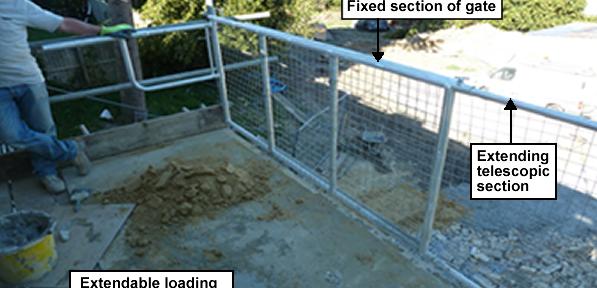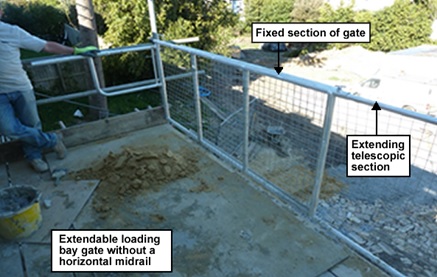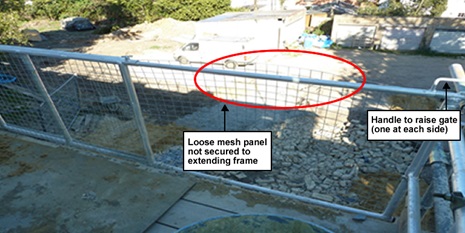
Scaffold Safety Alert
Posted on July 27, 2015
Issue: Poor design of scaffold loading bay gate, providing inadequate edge protection to prevent falls from height.
The HSE recently issued a bulletin notifying of number of manufacturers / suppliers who are marketing an extendable scaffold loading bay gate, which does not satisfy legal requirements, or applicable standards, when in some configurations.
When extended, the loading bay gate, which forms part of the edge protection on a scaffold, is not robust enough to fulfil this function and is therefore not suitable and sufficient to comply with the Work at Height Regulations 2005. This safety notice applies to all similar types of loading bay gate, as described below.
 This gate comprises two panels made up of tube and mesh (see photo above). One panel section is a fixed width, while the other is telescopic and can be adjusted to the required width of the loading bay. This allows a width adjustment from approximately 2300 mm to approximately 3900 mm. The mesh infill spans the full width and height of each panel. There is no horizontal mid-rail. This loading bay gate design is reported to be available in steel and aluminium.
This gate comprises two panels made up of tube and mesh (see photo above). One panel section is a fixed width, while the other is telescopic and can be adjusted to the required width of the loading bay. This allows a width adjustment from approximately 2300 mm to approximately 3900 mm. The mesh infill spans the full width and height of each panel. There is no horizontal mid-rail. This loading bay gate design is reported to be available in steel and aluminium.
The second instance found on a number of construction sites, a type of gate where the mesh was loose and able to detach when pushed (see photo below). It would not be able to withstand the weight of a person leaning, or in certainly falling against it, and would also allow loose materials to fall from the platform.

The Work at Height Regulations requires edge protection to be of suitable strength and rigidity and to comprise the equivalent of a top rail, a mid-rail and a toe board. Where there is no mid-rail present, any mesh panels or similar must be able to achieve an equivalent level of containment.
The full HSE alert can be found HSE Scaffold Safety Alert.
Interim actions to be introduced are as follows:
• One stainless cable tie every 300 mm and part of the seven day inspection. Unless the gate manufacturer / supplier allows a lighter duty cable tie, ties rated at minimum 75 kg loop tensile strength should be used.
• Options to allow the gates in question to be opened without workers being able to slip or trip and fall through the gap underneath the open gate, or the large gap while opening the gate, include remote opening using rope over a scaffold rail or pulley fixed above and inboard of the closed gate. Or moving the gate pivot further inboard and extending the operating levers – this may remove the need to fully rotate the gate during opening.
Both of these methods allow operation from the rear of the loading bay platform i.e. at least 2m back from the open edge.
If you would like to learn more about the safe erection of scaffolding, Courtley Heath & Safety offer a Basic Scaffold Inspection course. This covers the inspection of scaffolding and offers guidance on complying with the legal aspects of inspection.
If you would like further information please don’t hesitate to drop us an email at: [email protected] or give us a call on: 0151 545 0497.
